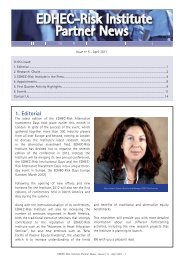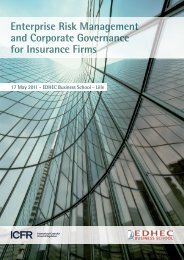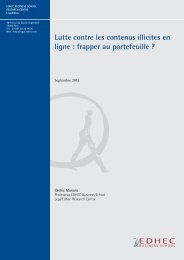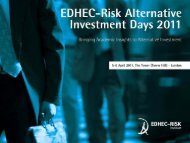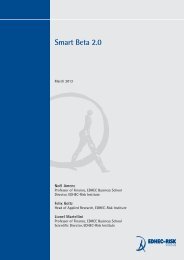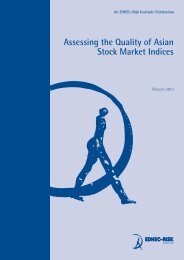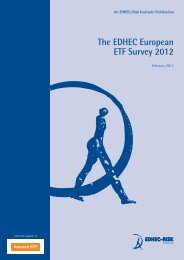Portfolios - EDHEC-Risk
Portfolios - EDHEC-Risk
Portfolios - EDHEC-Risk
You also want an ePaper? Increase the reach of your titles
YUMPU automatically turns print PDFs into web optimized ePapers that Google loves.
<strong>EDHEC</strong>-<strong>Risk</strong> Days 2012<br />
London, March 27th, 2012, 16:45-18:00<br />
Investing in New Forms of Equity Indices<br />
Lionel Martellini<br />
Professor of Finance, <strong>EDHEC</strong> Business School<br />
Scientific Director, <strong>EDHEC</strong> <strong>Risk</strong> Institute<br />
lionel.martellini@edhec.edu<br />
www.edhec-risk.com<br />
2
Inefficient i <strong>Portfolios</strong> in Efficient i Markets<br />
• For more than 50 years, the asset management industry has<br />
mainly focused on a single source of added-value:<br />
outperforming commercial indices through security selection.<br />
• This approach is based on two implicit assumptions:<br />
– Equity markets are inefficient markets;<br />
– Equity indices are efficient benchmarks.<br />
• Academic research has questioned these two assumptions:<br />
– Weak evidence of persistence in (positive) abnormal performance<br />
(alpha) by active managers => emergence of index funds;<br />
– Strong evidence of inefficiency of cap-weighted indices =><br />
emergence of alternative benchmarks.<br />
3
Managing Investments t in Alternative ti Indices<br />
• Once regarded as exotic curiosities, non CW equity indices have<br />
now made it into the mainstream.<br />
• This acceptance raises a new set of questions, and one may<br />
expect that adopting these non CW indices as benchmarks should<br />
require at least as much attention as investing in active managers.<br />
• Investors face in particular the following challenges:<br />
– Selecting alternative indices (vs. managers): in search for robustness<br />
– ad-hoc schemes versus schemes consistent with portfolio theory;<br />
– Diversifying alternative indices (vs. managers): different schemes<br />
perform differently in different market conditions;<br />
– Managing tracking error of alternative indices (vs. managers):<br />
diversification is not effective at managing extreme relative risk.
Outline<br />
• Alternatives to Cap-Weighted Indices<br />
• Diversifying the Diversifiers<br />
• Tracking the Tracking Error<br />
5
• Alternatives to Cap-Weighted Indices<br />
• Diversifying the Diversifiers<br />
• Tracking the Tracking Error<br />
6
Comparing Alternatives<br />
• A (non-exhaustive) list of recently implemented alternative<br />
weighting schemes :<br />
– Equally-weighted<br />
– Fundamentally-weighted<br />
– Maximum-diversification-weighted<br />
– <strong>Risk</strong>-parity-weighted<br />
it i – Diversity-weighted<br />
– Minimum-variance-weighted<br />
– Efficient-weighted<br />
• As opposed to focusing on past performance (track records -by<br />
definition- all look pretty good), we provide a summary of the<br />
objectives of, and assumptions behind, the various approaches.<br />
7
Indices versus Benchmarks<br />
• The words « index » and « benchmark » are often used<br />
interchangeably; yet they define a priori very different concepts.<br />
• Market perspective: an index is a portfolio that should<br />
represent the performance of a given segment of the market.<br />
=> focus on representativity<br />
• Investor perspective: a benchmark is a reference portfolio that<br />
should represent the fair reward expected in exchange for risk<br />
exposures that an investor is willing to accept.<br />
=> focus on efficiency<br />
• CW portfolios have long been portrayed as representative and<br />
efficient, but have faced increased criticism on both fronts.<br />
8
Cap-Weighting for Representativity?<br />
• A market cap weighted scheme is the obvious default option<br />
when it comes to representing a given segment of the market.<br />
– Market cap weighted indices provide by construction a fair<br />
representation of the stock market;<br />
– In the end, cap-weighting is nothing but an ad-hoc weighting<br />
scheme that t achieves some form of representativity.<br />
ti it<br />
• Cap-weighted indices, however, may not provide a fair<br />
representation of the underlying economic fundamentals.<br />
• Some have argued that t they represent well the stock market but<br />
not the economy.<br />
9
Fundamental Weighting for Representativity?<br />
• Rather than using the market cap, fundamental indices use<br />
firm attributes such as book value, dividends, sales or cash<br />
flows as measures of size.<br />
• These indices aim at better representing the economy.<br />
Arnott (2007): “The Fundamental Index weights companies in<br />
accordance to their footprint in the broad economy […] you wind up<br />
with a portfolio that mirrors the economy”.<br />
• Whether or not fundamentally weighted indices better<br />
represent the economy is actually an open question, if only<br />
because representativity is not a concept that is linked to clear<br />
measures.<br />
• Conditions under which fundamental benchmarks would be<br />
optimal are unclear.<br />
10
Efficiency is Related to Diversification<br />
• In any case, it is not clear why investors would care about their<br />
portfolios representing the economy; from the investor’s<br />
perspective, the focus should be on efficiency: obtaining fair<br />
rewards for given risk budgets.<br />
• Efficiency is intimately related to diversification: it is by<br />
constructing ti well-diversified ifi d portfolios thatt one can achieve a<br />
fair reward for a given risk exposure.<br />
• CW portfolios appear to be rather inefficient and poorly<br />
diversified portfolios, and several approaches have been<br />
developed so as to improve diversification compared to CW.<br />
• Some benchmark construction approaches simply avoid this<br />
concentration without aiming for “optimality”; other approaches<br />
are grounded d in portfolio theory.<br />
11
Scientific Approaches: Towards the Efficient Frontier<br />
• Scientific diversification aims at reaching a high risk/return<br />
objective through portfolio construction techniques.<br />
• Two remarkable portfolios on the efficient frontier:<br />
– The MSR generates the highest reward per unit of portfolio<br />
volatility: needed optimization inputs are expected returns,<br />
correlations and volatilities.<br />
– The GMV generates the lowest possible portfolio volatility: needed<br />
optimization inputs are correlations and volatilities.<br />
• In what follows, we focus on these two approaches, and discuss<br />
some of the challenges involved in robust optimization.<br />
• Ad-hoc approaches can generally be regarded as specific cases<br />
under some particular assumptions.<br />
12 12
MSR versus GMV<br />
Expected<br />
Return<br />
w<br />
−1<br />
( μ − re)<br />
( μ − re)<br />
Σ<br />
= ≡<br />
e'<br />
Σ<br />
( μ , σ , ρ )<br />
MSR −1<br />
i i ij<br />
f<br />
Maximum Sharpe<br />
Ratio (MSR) Portfolio<br />
Global<br />
Minimum<br />
Variance (GMV)<br />
Portfolio<br />
●<br />
−1<br />
1<br />
●<br />
●<br />
( )<br />
Σ e<br />
w GMV = ≡ g σ ,<br />
1<br />
e'<br />
e<br />
i ρ<br />
−<br />
Σ<br />
ij<br />
●<br />
Equally-weighted index<br />
Cap-weighted index<br />
Volatility<br />
13
Implementing the Diversifiers<br />
• Estimating covariance matrix parameters is a serious<br />
challenge, but a number of statistical techniques can prove<br />
effective in addressing this challenge.<br />
• If statistical techniques are useful for estimating risk<br />
parameter, statistics on the other hand does not allow us to<br />
estimate expected returns reliably.<br />
• Direct estimation of expected returns from past returns is close<br />
to useless (Merton (1980)).<br />
• What can we do in practice?<br />
– Give up “naïvely” on expected return estimation<br />
– Give up “smartly” on expected return estimation<br />
14
Giving Up Naïvely – Global Minimum Variance <strong>Portfolios</strong><br />
• The only scientifically diversified portfolio that relies only on risk<br />
parameters is the minimum risk portfolio (GMV in MV setting).<br />
• In its purest form, “magic” of diversification is not working<br />
properly with GMV portfolios because low volatility stocks are<br />
not penalized and therefore over-weighted.<br />
• We need to penalize low volatility stocks to avoid concentration<br />
in such stocks through weight constraints (flexible norm<br />
constraints versus rigid weight constraints – DeMiguel,<br />
Garlappi, Nogales and Uppal (2009)).<br />
15
Giving Up Smartly – MSR<br />
• How to penalize low volatility stocks based on economic theory?<br />
• Theory unambiguously confirms the existence of a positive<br />
risk/return relationship:<br />
– Systematic risk is rewarded (APT);<br />
– Specific risk is also rewarded (Merton (1987));<br />
– Total volatility (model-free) should therefore be rewarded;<br />
– Higher moment risk is also rewarded (many references).<br />
• This justifies the use of the risk-return relationship to build<br />
efficient portfolios: magic of diversification is about mixing highrisk-and-therefore-high-return<br />
stocks so as to generate low risk<br />
portfolios through a smart use of correlations.<br />
16
Ad-Hoc Approaches: EW and ERC (<strong>Risk</strong>-Parity)<br />
• Naïve de-concentration:<br />
– Equal-weighting simply gives the same weight to each of N stocks<br />
in the index (“1/N rule”)<br />
).<br />
– Equal-weighting is the naïve route to constructing well diversified<br />
portfolios<br />
– EW is optimal (e.g., MSR) if all stocks are identical.<br />
• Semi-naïve de-concentration:<br />
ti<br />
– Equal risk contribution (ERC) takes into account contribution to risk.<br />
– Contribution to risk is not proportional to dollar contribution.<br />
– Find portfolio weights such that contributions to risk (volatility) are<br />
equal (Maillard, Roncalli and Teiletche (2010)).<br />
– ERC is optimal (e.g., MSR) if all Sharpe ratios and all pairwise<br />
ERC is optimal (e.g., MSR) if all Sharpe ratios and all pairwise<br />
correlations are identical.<br />
17 17
Ad-Hoc Approaches: Maximum Diversification<br />
• Statistical de-concentration:<br />
– Define a diversification index and try and maximize it.<br />
– Maximum Diversification aims at generating portfolios with the<br />
highest possible diversification index (Choueifaty and Coignard<br />
(2008)):<br />
⎛ n<br />
⎞<br />
⎜<br />
⎟<br />
⎜∑<br />
wiσ<br />
i<br />
⎟<br />
DI = Max⎜<br />
i=<br />
1<br />
⎟<br />
w ⎜<br />
n ⎟<br />
⎟<br />
⎜ ⎜ ∑ w i w jσ<br />
ij<br />
⎟<br />
⎝<br />
i,<br />
j= 1 ⎠<br />
– MD is optimal (e.g., MSR) if all Sharpe ratios are identical.<br />
The weighted average risk (in the numerator) will be high compared<br />
to portfolio risk (in the denominator) and thus DI will be high if the<br />
portfolio weights exploit well the correlations.<br />
18
• Alternatives to Cap-Weighted Indices<br />
• Diversifying the Diversifiers<br />
• Tracking the Tracking Error<br />
19
Selection <strong>Risk</strong> – Relative Returns<br />
• Depending on market conditions, different strategies work<br />
differently; he worst performing strategy in one sub-period can<br />
turn out to be the best performer in subsequent sub-period<br />
period.<br />
Subperiod<br />
MSCI USA Minimum<br />
Volatility Index<br />
FTSE <strong>EDHEC</strong> <strong>Risk</strong><br />
Efficient US Index<br />
2003 (JanJun) ‐4.72% 2.46%<br />
2003 (JulDec) ‐2.93% 3.46%<br />
2004 (JanJun) 0.05% 3.28%<br />
2004 (JulDec) 2.64% 3.18%<br />
2005 (JanJun) 4.58% 3.95%<br />
2005 (JulDec) ‐3.85% 2.04%<br />
2006 (JanJun) ‐0.70% 0.82%<br />
2006 (JulDec) ‐2.54% ‐2.30%<br />
2007 (JanJun) ‐1.63% 2.06%<br />
2007 (JulDec) 1.51% ‐3.31%<br />
2008 (JanJun) 0.38% 1.46%<br />
2008 (JulDec) 10.10% ‐2.40%<br />
2009 (JanJun) ‐4.10% 7.58%<br />
2009 (JulDec) ‐3.75% 6.96%<br />
2010 (JanJun) 1.67% 3.73%<br />
2010 (JulDec) ‐2.06% 2.26%<br />
2011 (JanJun) 4.01% 3.39%<br />
2011 (JulDec) 6.36% ‐2.32%<br />
The table shows excess return over the cap‐weighted index (the S&P 500 index) of MSCI USA Minimum Volatility Index and FTSE <strong>EDHEC</strong> <strong>Risk</strong> Efficient US Index computed over<br />
16 half yearly sub‐periods. Weekly return data from 3 January 2003 to 30 December 2011 is used for the analysis.<br />
20
Selection <strong>Risk</strong> – Relative Perspective<br />
• Periods of very pronounced underperformance occurred for each<br />
of these indices, as can be seen from extremely high values for<br />
max relative drawdowns and extreme annual tracking error.<br />
<strong>Risk</strong> Measures<br />
MSCI USA<br />
Minimum<br />
Volatility Index<br />
FTSE <strong>EDHEC</strong><br />
<strong>Risk</strong> Efficient US<br />
Index<br />
Max relative drawdown 12.23% 8.43%<br />
Start date 21‐nov‐08 21‐apr‐06<br />
End date 23‐apr‐10 21‐nov‐08<br />
Annualised excess Return over<br />
capweighted index<br />
1.21% 3.75%<br />
Tracking Error (TE) 5.69% 3.82%<br />
Extreme Tracking Error (95 th<br />
percentile of rolling one year TE)<br />
7.42% 6.72%<br />
21
Diversifying the Diversifiers – Long-Term Analysis<br />
• Both diversifiers add value, as can be seen from the improvement<br />
in Sharpe ratio (without impact on extreme risk levels), but not<br />
necessarily under the same market conditions.<br />
CapWeighted<br />
Minimum<br />
Volatility<br />
Maximum Sharpe<br />
Ratio<br />
Ann Return 9.60% 10.89% 11.02%<br />
Ann Std 15.46% 14.10% 14.53%<br />
Ann Semi Dev 11.28% 10.39% 10.73%<br />
Tracking Error 0.00% 2.76% 2.77%<br />
Market β 1.00 0.90 0.93<br />
Sharpe Ratio 0.27 0.39 0.39<br />
Sortino Ratio 0.39 0.55 0.55<br />
Information Ratio ‐ 0.47 0.51<br />
Treynor Ratio 0.04 0.06 0.06<br />
Max Drawdown 53.83% 50.42% 51.72%<br />
95% VaR 3.31% 3.02% 3.14%<br />
99% VaR 7.77% 7.64% 7.77%<br />
Skewness ‐0.34 ‐0.50 ‐0.52<br />
Kurtosis 8.06 9.09 8.82<br />
95% ValueatTracking at Error <strong>Risk</strong><br />
(VaTER)<br />
‐<br />
3.89% 3.96%<br />
The period of analysis is from 2nd January 1959 to 31st December 2010. All statistics are annualized and performance ratios that involve the average returns are<br />
based on the geometric average.<br />
22
Relative Performance Across Market Conditions<br />
• Robust proxies for the GMV portfolio provide defensive exposure<br />
to equity that does well in adverse market conditions, while robust<br />
proxies for Max Sharpe Ratio portfolios provide a higher access<br />
to the upside of equity markets.<br />
Diversified (50% Minimum<br />
Minimum Volatility Maximum Sharpe Ratio Volatility + 50% Maximum<br />
Sharpe Ratio)<br />
Conditioning Variable Regime Excess Return over S&P 500 index<br />
Annualised Equity Market Excess<br />
Returns (Market –risk free rate)<br />
Low 3.20% 2.06% 2.63%<br />
2 2.62% 1.95% 2.29%<br />
3 0.78% 0.98% 0.88%<br />
4 ‐0.50% 0.94% 0.22%<br />
High ‐2.62% ‐0.10% ‐1.36%<br />
Conditioning Variable Regime Excess Return over S&P 500 index<br />
Annualised Market Volatility (of<br />
Excess Market Return)<br />
Low 1.40% 2.53% 1.96%<br />
2 1.01% 1.03% 1.02%<br />
3 ‐0.10% ‐0.07% ‐0.08%<br />
4 1.64% 2.05% 1.85%<br />
High 2.24% 1.58% 1.91%<br />
23
Tracking Error Across Market Conditions<br />
• A combination of both approaches is expected to lead to a<br />
smoother conditional performance, and a lower relative risk with<br />
respect to the cap-weighted index.<br />
Minimum Volatility<br />
Maximum Sharpe Ratio<br />
Diversified (50% Minimum<br />
Volatility + 50% Maximum<br />
Sharpe Ratio)<br />
Conditioning Variable Regime Tracking Error with S&P 500 index<br />
Annualised Equity Market Excess<br />
Returns (Market –risk free rate)<br />
Low 3.28% 3.30% 3.23%<br />
2 2.12% 2.17% 2.10%<br />
3 1.81% 1.82% 1.77%<br />
4 2.21% 21% 2.18% 2.14%<br />
High 2.37% 2.54% 2.41%<br />
Conditioning Variable Regime Tracking Error with S&P 500 index<br />
Annualised Market Volatility (of<br />
Excess Market Return)<br />
Low 1.55% 1.72% 1.59%<br />
2 1.78% 1.78% 1.73%<br />
3 1.99% 2.08% 1.99%<br />
4 2.45% 2.50% 2.42%<br />
High 3.97% 3.89% 3.87%<br />
24
Extreme Tracking Error Across Market Conditions<br />
• In 7 out of 10 cases, the diversified strategy does not lower<br />
VaTER compared to the individual strategy with the lowest<br />
VaTER; this is hardly surprising: diversification is not meant to<br />
address extreme risk, and we should turn to hedging.<br />
Diversified (50% Minimum<br />
Minimum Volatility Maximum Sharpe Ratio Volatility + 50% Maximum<br />
Sharpe Ratio)<br />
Conditioning Variable Regime 95% Value at Tracking Error <strong>Risk</strong><br />
Annualised Equity Market Excess<br />
Returns (Market –risk free rate)<br />
Low 5.13% 4.99% 5.13%<br />
2 2.92% 3.11% 2.89%<br />
3 3.18% 3.03% 2.99%<br />
4 3.65% 3.50% 3.52%<br />
High 4.95% 4.66% 4.71%<br />
Conditioning Variable Regime 95% Value at Tracking Error <strong>Risk</strong><br />
Annualised Market Volatility (of Excess<br />
Market Return)<br />
Low 2.39% 2.83% 2.54%<br />
2 3.02% 2.86% 2.86%<br />
3 3.33% 3.59% 3.50%<br />
4 4.06% 4.05% 3.90%<br />
High 7.10% 6.77% 7.11%<br />
25
• Alternatives to Cap-Weighted Indices<br />
• Diversifying the Diversifiers<br />
• Tracking the Tracking Error<br />
26
Tracking the Tracking Error<br />
• Even with a combination of a minimum volatility portfolio and a<br />
maximum Sharpe ratio portfolio, extreme tracking error risk<br />
remains substantial.<br />
• This extreme relative risk is a severe concern for a Chief<br />
Investment Officer who has made the choice of adopting an<br />
alternative weighting scheme.<br />
When such underperformance occurs with active managers, the failure of a<br />
third-party manager, which is a risk inherent to the very logic of the delegation<br />
process of portfolio management, typically translates into the termination of<br />
the manager.<br />
In the case of underperformance of an alternative ti equity index, however, it<br />
would be difficult for the CIO to blame anyone but himself/herself for the<br />
selection of this index.<br />
27
Tracking Error Constraints<br />
• If we subject active managers to TE control, why not expect the<br />
same requirements from alternative benchmarks?<br />
• To control tracking error, one may perform a maximum Sharpe<br />
ratio or minimum variance portfolio optimization subject to<br />
tracking error constraints.<br />
• This is an inefficient approach, inconsistent with the fund<br />
separation theorems that lie at the foundation of asset pricing<br />
theory, and which suggests instead to use a core-satellite<br />
approach.<br />
• In fact, the two approaches are not strictly mutually exclusive.<br />
28
“Fund Separation Theorem” Approach to TE Control<br />
• Fund separation theorems recognize that t risk and performance<br />
are conflicting objectives that are best managed when managed<br />
separately.<br />
• In simple words, the optimal solution in the presence of TE<br />
constraints is a mixture of some proxy for a well-diversified MSR<br />
portfolio and the CW benchmark, here the risk-free asset:(*)<br />
w<br />
⎛ ⎞<br />
= −<br />
CW MSR<br />
⎟<br />
w<br />
t = c<br />
t w<br />
t + 1<br />
⎝ γσ<br />
14243 144<br />
243<br />
⎠ 4<br />
* λt<br />
MSR λt<br />
t w<br />
t +<br />
1<br />
γσ<br />
⎜<br />
t<br />
t<br />
speculative demand<br />
HD w.r.t. benchmark risk<br />
( − c<br />
CW<br />
t ) w<br />
t<br />
• The risk-aversion parameter γ is calibrated to as to reach a<br />
target TE level; for a given γ, the weight allocated to the<br />
improved vs. CW portfolio is a function of market conditions.<br />
29<br />
(*) Result based on constrained maximization of expected CRRA utility of terminal wealth relative to CW benchmark.
What Separation Theorems Say and Do not Say<br />
• This approach is sometimes known as core-satellite investing,<br />
and in essence strictly similar to LDI when the benchmark is a<br />
liability-driven benchmark.<br />
• Now, this approach works even better when the TE of the<br />
satellite portfolio is “well-behaved”; a concern over VaTER in<br />
particular would lead to a severe opportunity cost.<br />
• Therefore, when designing the alternatively weighted satellite<br />
part, it is still useful to maximise the Sharpe ratio subject to<br />
suitably defined (relatively loose, e.g., 5%) TE constraints.<br />
• Adding beta constraints (with respect to a number of betas<br />
that may vary as a function of market conditions) is<br />
particularly effective in controlling for VaTER.<br />
30
Impact of Relative <strong>Risk</strong> Control<br />
• Extreme tracking error is markedly lower for the relative risk<br />
controlled portfolios (ex-ante TE target: 3%).<br />
Minimum<br />
Volatility<br />
Without Relative <strong>Risk</strong> Control<br />
Maximum Sharpe<br />
Ratio<br />
Diversified (50%<br />
Minimum<br />
Volatility + 50%<br />
Maximum Sharpe<br />
Ratio)<br />
Minimum<br />
Volatility<br />
With Relative <strong>Risk</strong> Control<br />
Maximum Sharpe<br />
Ratio<br />
Diversified (50%<br />
Minimum<br />
Volatility + 50%<br />
Maximum Sharpe<br />
Ratio)<br />
Expected Return over CW 1.29% 1.42% 1.35% 0.79% 1.18% 0.99%<br />
Information Ratio 0.47 0.51 0.50 0.44 0.52 0.54<br />
Modified IR 0.23 0.28 0.27 0.25 0.29 0.30<br />
Median Relative Return 1.06% 1.46% 1.35% 0.67% 1.14% 1.12%<br />
5% Relative Return ‐4.49% ‐4.35% ‐4.32% ‐2.94% ‐3.60% ‐3.15%<br />
Min Relative Return ‐12.01% ‐10.57% ‐11.29% ‐8.45% ‐7.05% ‐7.68%<br />
Median Tracking Error 2.08% 2.15% 2.05% 1.53% 1.87% 1.51%<br />
95% Tracking Error 5.60% 5.09% 5.07% 3.09% 4.03% 3.26%<br />
Max Tracking Error 8.69% 8.36% 8.51% 4.48% 5.20% 4.77%<br />
Max Relative Drawdown 22.96% 21.05% 21.83% 15.78% 14.65% 14.88%<br />
Start t Date 16‐sept‐93 24‐mar‐94 7‐oct‐93 16‐sept‐93 22‐sept‐94 24‐mar‐94<br />
End Date 24‐mar‐00 24‐mar‐00 24‐mar‐00 24‐mar‐00 24‐mar‐00 24‐mar‐00<br />
Weekly ValueatTracking<br />
Error <strong>Risk</strong> (VaTER)<br />
‐0,54% ‐0,55% ‐0,54% ‐0,38% ‐0,45% ‐0,38%<br />
Max TUW (weeks) 340 313 337 340 287 313<br />
Prob of Outperformance (1Y<br />
Rel Return)<br />
Prob of Outperformance (3Y<br />
Rel Return)<br />
66.00% 65.03% 67.09% 64.65% 64.95% 67.47%<br />
75.96% 75.84% 76.86% 76.31% 70.84% 76.39%<br />
31
Impact of Relative <strong>Risk</strong> Control<br />
Panel A: Relative Drawdown of Diversified Strategy with and<br />
without relative risk control<br />
0%<br />
Panel B: Rolling Oneyear Tracking Error of Diversified Strategy<br />
with and without relative risk control<br />
9%<br />
8%<br />
‐5%<br />
‐10%<br />
‐15%<br />
‐20%<br />
7%<br />
6%<br />
5%<br />
4%<br />
3%<br />
2%<br />
1%<br />
‐25%<br />
0%<br />
Diversified ifi (with RR control) Diversified ifi (without t RR control) Diversified ifi (with RR control) Diversified ifi (without t RR control)<br />
The plot shows relative drawdown of diversified portfolios (50% Minimum Volatility + 50% Maximum Sharpe Ratio) with and without relative risk<br />
control as compared to the S&P 500 index. Panel B ‐ The plot shows 1‐year trailing tracking error for Diversified (50% Minimum Volatility + 50%<br />
Maximum Sharpe Ratio) portfolios with and without relative risk control as compared to the S&P 500 index. The period of analysis ranges from 2nd<br />
January 1959 to 31st December 2010.<br />
32
Improved Benchmarks in Investors’ <strong>Portfolios</strong><br />
• CW indices are macro-consistent, relatively transparent,<br />
systematic and come with low-cost, and will arguably remain the<br />
ultimate references; on the other hand, they provide severely<br />
inefficient risk/reward properties due to their high concentration.<br />
• Active managers come with less transparency and higher h costs<br />
but have difficulties in persistently outperforming even inefficient<br />
CW indices due to a focus on stock selection.<br />
• More efficient equity benchmarks can be designed, which may<br />
be used as substitutes for active managers in attempts to add<br />
value with respect to the CW index, while allowing for an explicit<br />
control of downside relative risk through diversification and<br />
hedging.<br />
33




